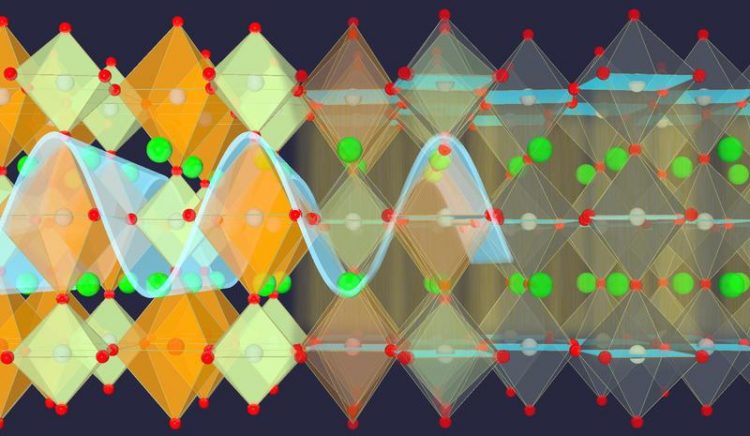Scientists shine new light on the “other high temperature superconductor”

Intense laser pulses were used to photo-excite bismuthate compounds, in which “charge-density-waves” (left side) coexist with superconductivity (right side). Image: Joerg M. Harms, MPSD
Since the beginning of the 20th century, superconductivity had been observed in some metals at temperatures only a few degrees above the absolute zero (minus 273 degrees Celsius). Only in the 1980s, physicists managed to synthetize new classes of compounds, based on ceramic materials, which were able to conduct electricity without any losses at temperatures as high as 138 K (minus 135 degrees Celsius). These were named “high temperature superconductors”.
The best known and heavily studied family of high temperature superconductor is that of cuprates, which display by far the highest critical temperatures (i.e. the temperature below which superconductivity occurs), and are therefore the most promising for applications. However, a wide variety of other compounds exists, which also manifest superconductivity at fairly high temperatures, among them the recently discovered iron pnictides.
A universal picture able to describe the physics behind the phenomenon of high temperature superconductivity is still missing. However, an important commonality between almost all high temperature superconductors is the emergence of superconductivity in proximity of other exotic phases of matter, such as the “charge-density-waves”.
All these materials can be typically tuned from one phase to another, possibly achieving superconductivity, by chemical doping, external pressure, or magnetic fields. However, the subtle inter-relation of these phases remains poorly understood, and in some case, there are evidences that charge-density-waves and superconductivity can even coexist microscopically in the very same compound.
In such circumstances, experiments performed by stimulating materials with ultrashort, intense laser pulses (as short as few hundreds of femtoseconds) have been shown in the past to provide new insights in the physics of these systems. For example, the group of Andrea Cavalleri at the MPSD in Hamburg has already successfully demonstrated that, in some cuprates compounds, such pulses can be used to remove charge-density-waves and promote superconductivity at higher temperatures, possibly even up to room temperature (see links below: W. Hu, Nature Materials, 13, 705–711 and R. Mankowsky, Nature 516 , 71–73).
In the present work, Nicoletti, Cavalleri and coworkers focused on different compounds, belonging to the poorly studied family of bismuthates. These superconductors were discovered in the 1970s, even before the cuprates, but they attracted less attention due to their far lower critical temperatures (about 30 K). They share many commonalities, but also some differences with their better-known relatives. In particular, the so-called “parent compound”, BaBiO(3), has a robust charge-density-wave phase, from which superconductivity emerges by chemical substitution.
High quality crystals of BaPb(1-x)BixO(3), with different Pb concentrations “x”, were synthetized and characterized by Ian R. Fisher and P. Giraldo-Gallo at Stanford University, California. The Hamburg team performed a series of experiments on these crystals, in which they photo-excited the materials with very short and intense laser pulses and measured how their conductivity was transiently modified and relaxed back to the initial value within few picoseconds.
By analysing the dependence of such signal on frequency, temperature, and Pb concentration, they could uniquely assign it to a modification of the charge-density-wave phase induced by the laser field.
“Strikingly”, says Nicoletti, “we were able to measure this response not only in the parent compound BaBiO(3), for which a charge-density-wave is well known to exist, but also in a Pb-doped superconducting compound. This observation is an indirect demonstration of the coexistence of charge-density-waves and superconductivity in the very same material, something that has been discussed previously, but never definitely established in this class of materials”.
The scientists were also able to exactly determine the energy scales associated with the modification of the charge-density-waves, thus providing new information on their dynamical interplay with superconductivity in bismuthates.
These results are especially timely given that charge-density-waves have recently been found in several cuprate superconductors, pointing towards a surprising commonality between some aspects of these materials. The present experiment is an additional example of how light can be employed to investigate, control, and manipulate complex materials. One of the ultimate goals of this line of research is to provide guidance for material engineering to develop new functionalities at increasingly higher temperatures.
This work was supported by the ERC Synergy Grant “Frontiers in Quantum Materials’ Control” (Q-MAC), the Hamburg Centre for Ultrafast Imaging (CUI), and the priority program SFB925 of the Deutsche Forschungsgemeinschaft. The experiments were performed in the laboratories of the Center for Free-Electron Laser Science (CFEL), a joint enterprise of DESY, the Max Planck Society, and the University of Hamburg. The research was carried out in close collaboration with scientists of Stanford University, California, USA.
Contact: Dr. Daniele Nicoletti, corresponding author, +49 (0)40 8998-6208, daniele.nicoletti@mpsd.mpg.de
https://dx.doi.org/10.1073/pnas.1707079114 – Original publication
http://www.mpsd.mpg.de/116013/1412-vibes-for-superc-cavalleri – Superconductivity without cooling (2014)
http://www.mpsd.mpg.de/84292/2014-05-hint-for-sc-at-room-temperature – A first hint for superconductivity at room temperature (2014)
Media Contact
All latest news from the category: Materials Sciences
Materials management deals with the research, development, manufacturing and processing of raw and industrial materials. Key aspects here are biological and medical issues, which play an increasingly important role in this field.
innovations-report offers in-depth articles related to the development and application of materials and the structure and properties of new materials.
Newest articles

First-of-its-kind study uses remote sensing to monitor plastic debris in rivers and lakes
Remote sensing creates a cost-effective solution to monitoring plastic pollution. A first-of-its-kind study from researchers at the University of Minnesota Twin Cities shows how remote sensing can help monitor and…

Laser-based artificial neuron mimics nerve cell functions at lightning speed
With a processing speed a billion times faster than nature, chip-based laser neuron could help advance AI tasks such as pattern recognition and sequence prediction. Researchers have developed a laser-based…

Optimising the processing of plastic waste
Just one look in the yellow bin reveals a colourful jumble of different types of plastic. However, the purer and more uniform plastic waste is, the easier it is to…



